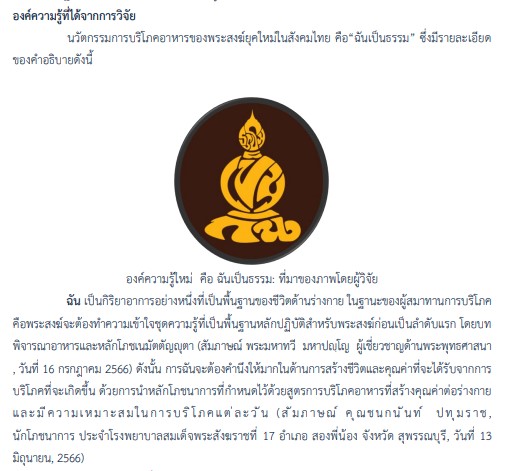BUDDHIST FOOD CONSUMPTION INNOVATIONS OF NEW AGE MONK IN THAI SOCIETY
Main Article Content
Abstract
Buddhist food consumption innovations of new era monks in Thai society, have the purpose: (1) to study the concepts, and theories of food consumption according to nutritional principles; (2) to study the current state of food consumption by monks in Thai society; and (3) to present Buddhist innovations in the food consumption of new era monks in Thai society.
The research results found that: Monks and modern consumption in the capitalist world, is consumption for identity creation, which results in neglecting the true goal, causing health problems. Using the principles of nutrition in consuming food, according to the 5 food groups as a basis is therefore necessary, and the food consumption of Buddhism in food considerations and Principles of Moderations eating. There are principles of Buddhism, namely mindfulness, carelessness and moderation. It is consumption to purify the mind that is considered as the most important, and the model is, “Eat As Dhamma”. “Eat” means choosing to consume food, in proportion to your physical needs, according to nutritional principles, and using the principles of mindfulness and moderation in food consumption as a tool for regulating food consumption. “As” is to manage knowledge from an understanding of food consumption choices. And it leads to action by using mindfulness to see, smell, taste, and think about when you want to consume food again, that is, "know how to eat" And "Dhamma" is the result of “Eat As” (“know how to eat"), which is the emergence of wisdom that makes one understand the true goal, and leads to action that brings balance to the body's health, which is “Get nutritional value, and benefit in developing the mind.”
Article Details

This work is licensed under a Creative Commons Attribution-NonCommercial-NoDerivatives 4.0 International License.
เรื่องลิขสิทธิ์/เป็นความคิดเห็นของผู้เขียน
References
หนังสือ
พระมหาโพธิวงศาจารย์ (ทองดี สุรเตโช). (2547). ศัพท์วิเคราะห์. กรุงเทพมหานคร: สำนักพิมพ์เลี่ยงเซียง.
พระพรหมคุณาภรณ์ (ป.อ. ปยุตฺโต). (2546). พจนานุกรมพุทธศาสน์ ฉบับประมวลธรรม. กรุงเทพมหานคร:
สำนักพิมพ์ผลิธัมม์.
มหาจุฬาลงกรณราชวิทยาลัย. (2539). พระไตรปิฎกภาษาไทย ฉบับมหาจุฬาลงกรณราชวิทยาลัย. กรุงเทพ-
มหานคร: โรงพิมพ์มหาจุฬาลงกรณราชวิทยาลัย.
สมเด็จพระมหาสมณเจ้า กรมพระยาวชิรญาณวโรรส. (2554). นวโกวาท. พิมพ์ครั้งที่ 42. กรุงเทพมหานคร:
มหาวิทยาลัยมหามกุฏราชวิทยาลัย.
อัญชลี ศรีเจริญ. (2553). อาหารและโภชนาการ การป้องกันและบำบัดโรค. กรุงเทพมหานคร: สำนักพิมพ์แห่ง
จุฬาลงกรณ์มหาวิทยาลัย.
วารสาร
อัจฉริยา พ่วงแก้ว. (มกราคม-มิถุนยายน). พัฒนารูปแบบส่งเสริมการบริโภคอาหารของพระสงฆ์ : มุมมอง
ของพระสงฆ์. วารสารวิจัยทางวิทยาศาสตร์สุขภาพ: 2560; 12 (1); 81-91.
สื่ออิเล็กทรอนิกส์
นิยม กริ่มใจ. แนวโน้มค่านิยมพฤติกรรมผู้บริโภคในสังคมไทย ศตวรรษที่ 21. ออนไลน์, [แหล่งที่มา]
https://apheit.bu.ac.th/ (วันที่สืบค้น 16 พฤศจิกายน 2565).
THE STANDARD. กรมอนามัยเผย พระสงฆ์เกินครึ่งป่วยเบาหวาน-ความดันสูง แนะประชาชนลดใส่บาตร
ของหวาน มัน เค็ม. ออนไลน์ [แหล่งที่มา] https://thestandard.co/ (วันที่สืบค้น 11 มีนาคม
.
สัมภาษณ์
ชนกนันท์ ปทุมราช. นักโภชนาการชำนาญการ ประจำโรงพยาบาลสมเด็จพระสังฆราชที่ 17. วันที่สัมภาษณ์
มิถุนายน 2566.
พระมหาทวี มหาปญฺโญ. ผู้เชี่ยวชาญด้านพระพุทธศาสนา. วันที่สัมภาษณ์ 16 กรกฎาคม 2566.
พระสมุห์นิพนธ์ จรณธมฺโม. พระสงฆ์ผู้สมาทานการบริโภคอาหาร. วันที่สัมภาษณ์ 13 มิถุนายน 2566.


